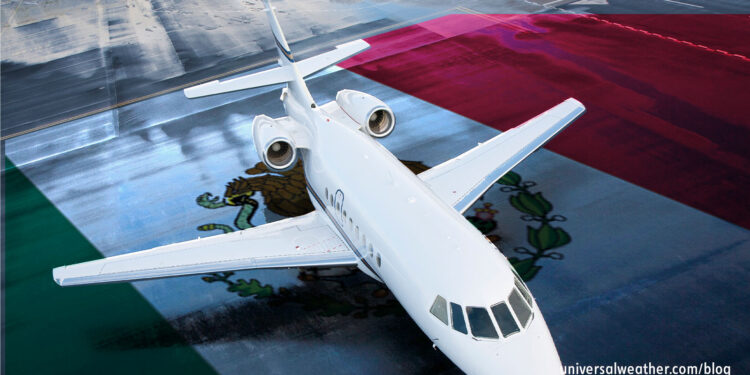Business Aviation Operations in Mexico – Understanding Airport Ops

This is a post by authors Manuel Girault and Jorge Alva. Manuel and Jorge are based at Universal Aviation Mexico, which has an FBO facility in Toluca and aircraft ground handling facilities in Cancun, Los Cabos and Cozumel. Manuel is an expert on business aircraft operations in Mexico and can be contacted at manuelgirault@universalaviation.aero or jorgealva@universalaviation.aero.
This business aviation blog post is part of a series on operating in Mexico.
Many airports in Mexico have curfews and overtime restrictions that should be taken into consideration when planning your next business aviation trip. It’s always best to coordinate with your 3rd-party provider and ground handler to confirm airport procedures prior to any operation to Mexico.
The following is an overview of what you need to know:
1. Be aware of airport curfews
Toluca (MMTO), Cancun (MMUN), Guadalajara (MMGL) and Puerto Vallarta (MMPR) operate 24 hours, but other airports in Mexico have limited operating hours. Overtime is possible at many airports at the discretion of the airport Commandante, but there are restrictions. Overtime may only be obtained for specific time periods after the scheduled airport closure. Charges are assessed for every 30 minutes past airport closing time. At least two hours’ advance notification is required to arrange overtime, but it’s recommended to provide airport authorities with six to eight hours’ notice. Both the Air Navigation Authority (SENEAM) and Civil Aviation Authority (DGAC) assess overtime charges of approximately 150-200 USD per 30-minute period, regardless of aircraft size or type.
2. There are no noise restrictions in Mexico
Stage 2 operations are not restricted in Mexico. There are no restrictions in place based on age of aircraft, so long as the aircraft is airworthy.
3. Know special airport procedures and processes
When arriving in Mexico from the south or from the Caribbean, aircraft must first land at either Cozumel (MMCZ) or Tapachula (MMTP) for security clearing. This process involves the Mexican military and customs clearance and takes 30-60 minutes. Be aware that Mexico City (MMMX) is available for scheduled commercial, government and diplomatic flights only, as well as authorized flights for maintenance purposes with prior permission required (PPR). Wide-body aircraft require airport slots for MMMX and MMUN, and there are arrival and departure restrictions at certain times. Therefore, it’s best to speak to your ground handler. Airport slot deviations vary depending on the availability of slots, and peak hours of scheduled commercial operations should be avoided at these airports.
4. Be aware of other operating considerations
Airport construction activity is currently ongoing at MMCZ, MMUN and Monterrey Escobedo (MMMY). As construction activity does not impact arrivals or departures, it’s not indicated by NOTAM. The condition of airport tarmac, taxiways and runways is good at international airports, but may be in need of repair at smaller domestic airfields. There are usually no restrictions on aircraft parking at Mexican airports, and extended stays are possible. If an aircraft needs to be relocated on the ramp, the crew will be advised. Depending on the airport, the crew may need to be present for aircraft repositioning on the field. At some airports, however, the crew can choose to leave the parking brake released so that aircraft may be relocated without the crew being present. At some airports, business aircraft are parked in separate areas, while at other airports, parking is separated by wide- and narrow-body aircraft.
5. Hangar space is not usually available
At most airports in Mexico, hangar facilities are not available for transient business aircraft. Limited hangar space can be found at MMTO, MMGL, Monterrey Del Norte (MMAN), Queretaro (MMQT) and MMMY. Your ground handler will assist with hangar arrangements.
6. Commercial aircraft have fueling priority
At most airports, scheduled commercial operations take priority over business aviation. Fuel priority goes to scheduled commercial ops even if you have the fuel uplift pre-booked. For this reason, it’s best to consider fueling upon arrival. There’s often just one government-owned and ASA-operated fueler at the airport. A few airports in Mexico – MMTO, MMPR, MMGL and Cabo San Lucas (MMSL) – have private fuel trucks available.
7. Know required procedures in the event of AOG
In the case of an Aircraft on Ground (AOG), or when maintenance is required, there are regulations impacting the importation of aircraft parts and supplies. Specific paperwork is required, and that must be done via a customs broker. Your ground handler will be able to advise on the necessary steps to take.
Conclusion
While parking availability is not usually problematic in Mexico, there are issues to consider in terms of fuel delivery, credit and payment of government fees. Your ground handler is a valuable resource in managing operating complexities and ensuring that airport delays are avoided.
Questions?
If you have any questions about this article or if you would like assistance with planning your next trip to Mexico, contact us at manuelgirault@universalaviation.aero or jorgealva@universalaviation.aero.
Later, we’ll discuss ground handling for Mexico and its impact on your trip.




